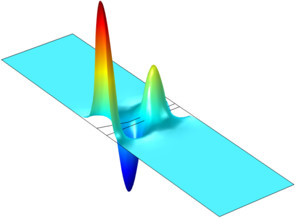Conical Quantum Dot
Application ID: 723
Quantum dots are nano- or microscale devices created by confining free electrons in a 3D semiconducting matrix. Those tiny islands or droplets of confined “free electrons” (those with no potential energy) present many interesting electronic properties. They are of potential importance for applications in quantum computing, biological labeling, or lasers, to name only a few.
Quantum dots can have many geometries including cylindrical, conical, or pyramidal. This model studies the electronic states of a conical InAs quantum dot grown on a GaAs substrate. To compute the electronic states taken on by the quantum dot/wetting layer assembly embedded in the GaAs surrounding matrix, the 1-band Schrödinger equation is solved. The four lowest electronic energy levels with corresponding eigenwave functions for those four states are solved in this model using the Coefficient form in COMSOL Multiphysics.
The model was based upon the paper: R. Melnik and M. Willatzen, “Band structure of conical quantum dots with wetting layers,” Nanotechnology, vol. 15, 2004, pp. 1-8.

この model の例は, 通常次の製品を使用して構築されるこのタイプのアプリケーションを示しています.
ただし, これを完全に定義およびモデル化するには, 追加の製品が必要になる場合があります. さらに, この例は, 次の製品の組み合わせのコンポーネントを使用して定義およびモデル化することもできます.
アプリケーションのモデリングに必要な COMSOL® 製品の組み合わせは, 境界条件, 材料特性, フィジックスインターフェース, パーツライブラリなど, いくつかの要因によって異なります. 特定の機能が複数の製品に共通している場合もあります. お客様のモデリングニーズに適した製品の組み合わせを決定するために, 製品仕様一覧 を確認し, 無償のトライアルライセンスをご利用ください. COMSOL セールスおよびサポートチームでは, この件に関するご質問にお答えしています.
